This material is soluble in ethanol at 50 mg/mL and water at 45 mg/mL. Stock solutions may be autoclaved or filter sterilized. The compound is light sensitive. Stock solutions should be stored protected from light in amber glass bottles and are stable for at least 6 months at 2 - 8°C.
C9754
Colchicine
≥95% (HPLC), powder, antimitotic agent
Synonym(s):
(S)-N-(5,6,7,9-Tetrahydro-1,2,3,10-tetramethoxy-9-oxobenzo[a]heptalen-7-yl)acetamide
About This Item
Recommended Products
Product Name
Colchicine, ≥95% (HPLC), powder
Quality Level
Assay
≥95% (HPLC)
form
powder
color
white to yellow
mp
150-160 °C (dec.) (lit.)
solubility
ethanol: 50 mg/mL
SMILES string
COC1=CC=C2C(=CC1=O)[C@H](CCc3cc(OC)c(OC)c(OC)c23)NC(C)=O
InChI
1S/C22H25NO6/c1-12(24)23-16-8-6-13-10-19(27-3)21(28-4)22(29-5)20(13)14-7-9-18(26-2)17(25)11-15(14)16/h7,9-11,16H,6,8H2,1-5H3,(H,23,24)/t16-/m0/s1
InChI key
IAKHMKGGTNLKSZ-INIZCTEOSA-N
Gene Information
human ... ABCB1(5243) , CYP3A4(1576) , TUBA1A(7846) , TUBA1B(10376) , TUBA1C(84790) , TUBA3C(7278) , TUBA3E(112714) , TUBA4A(7277) , TUBB(203068) , TUBB1(81027) , TUBB2A(7280) , TUBB2B(347733) , TUBB3(10381) , TUBB4A(10382) , TUBB4B(10383) , TUBB6(84617) , TUBB8(347688)
mouse ... Abcb1a(18671) , Abcb1b(18669)
Looking for similar products? Visit Product Comparison Guide
General description
Application
Biochem/physiol Actions
Features and Benefits
Storage and Stability
Signal Word
Danger
Hazard Statements
Precautionary Statements
Hazard Classifications
Acute Tox. 2 Oral - Muta. 1B
Storage Class Code
6.1A - Combustible acute toxic Cat. 1 and 2 / very toxic hazardous materials
WGK
WGK 3
Flash Point(F)
Not applicable
Flash Point(C)
Not applicable
Personal Protective Equipment
Choose from one of the most recent versions:
Certificates of Analysis (COA)
Don't see the Right Version?
If you require a particular version, you can look up a specific certificate by the Lot or Batch number.
Already Own This Product?
Find documentation for the products that you have recently purchased in the Document Library.
Customers Also Viewed
Articles
Discover Bioactive Small Molecules for ADME/Tox
-
How should this colchicine be dissolved to create a solution?
1 answer-
Helpful?
-
-
What is the solubility of product C9754, Colchicine? Also, what is the solution stability of Colchicine?
1 answer-
The solubility of Colchicine in DMSO is 426 mg/ml at 25 °C. It can also be dissolved in absolute ethanol (50 mg/ml), producing a clear to slightly hazy, yellow to yellow-green solution. However, this may require heat.
Regarding solution stability, Colchicine powder darkens upon exposure to light. Sterilized solutions remain stable for at least six months if shielded from light. No significant hydrolysis of colchicine occurred in neutral and slightly alkaline solutions after two months of frozen storage.
Helpful?
-
-
How should Colchicine be stored as a powder and when dissolved? At which temperature?
1 answer-
This product in powdered format can be stored in room temperature. Colchicine powder will darken upon exposure to light. Colchicine solutions can be sterilized by autoclaving or filtration. Sterilized solutions are stable for at least six months if protected from light. No appreciable colchicine hydrolysis occurred in neutral and slightly alkaline (pH = 8.1) solutions after storage frozen for 2 months.
Helpful?
-
Active Filters
Our team of scientists has experience in all areas of research including Life Science, Material Science, Chemical Synthesis, Chromatography, Analytical and many others.
Contact Technical Service













